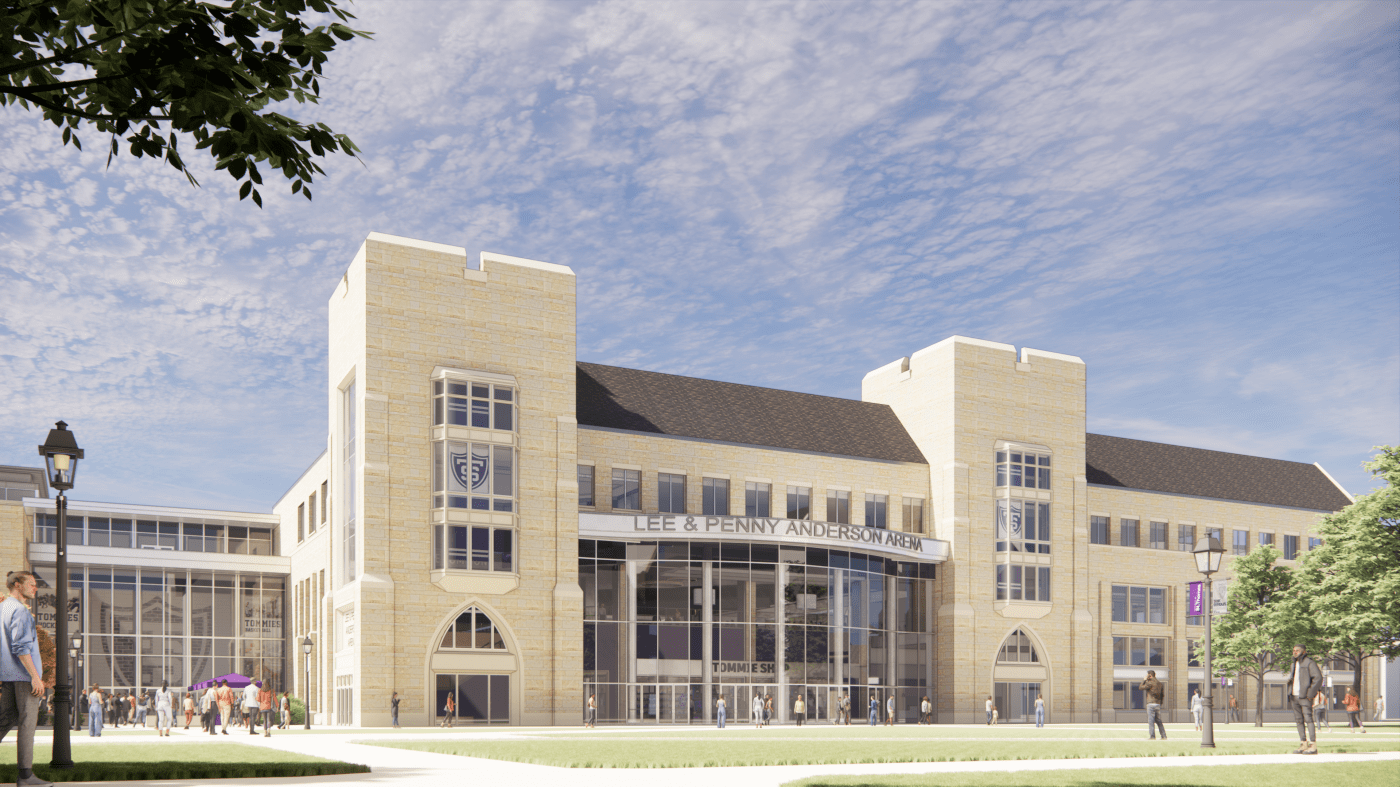
St. Paul: University of St. Thomas neighbors rebuffed in efforts against D1 hockey/basketball arena
When Jerome Abrams, a retired abdominal surgeon, learned that the University of St. Thomas planned to install a Division I hockey and basketball arena near his St. Paul home, he pulled out a tape measure.
A light snowfall had accumulated along Fairmount Avenue. By his calculation, in areas where cars were parked on both sides of the street, the travel lanes had been reduced to 8 feet in width in each direction.
“A fire engine is 10 feet, and so is an ambulance,” said Abrams, who lives with his wife near Woodlawn Avenue and Fairmount, two blocks south of the St. Paul campus. “I view it as a serious problem since I’m getting on in years.”
Demolition and site prep continue at the future site of the University of St. Thomas hockey and basketball arena across the street from the new Schoenecker Center on Thursday, Feb. 8, 2024. (John Autey / Pioneer Press)
University officials maintain those concerns haven’t fallen on deaf ears. They’re actively working on traffic mitigation strategies, such as online ticket sales with assigned parking spots and possible shuttle bus arrangements that could pick up sports fans by Allianz Field in the Midway on especially busy game days.
“They’re worried about traffic and parking,” said Amy McDonough, chief of staff in the office of university president Rob Vischer, in a recent interview. “So are we. We’re not saying there’s not going to be impacts.”
Still, McDonough noted, the arena’s most popular events will likely top out at 5,300 attendees a handful of times each year, and seating capacity will be roughly one-fourth that of Allianz Field, or 1,000 seats larger than James Griffin Stadium at Central High School. Most events, she said, will be managed like current football games at the O’Shaughnessy Stadium on campus, which also has capacity for more than 5,000 fans.
“It’s not the Xcel Energy Center,” McDonough said.
Committees rebuff efforts to halt construction
Twice in as many weeks, Abrams and other Macalester-Groveland homeowners living near Minnesota’s largest private university have approached officials at St. Paul City Hall, demanding that they put a halt to the Lee and Penny Anderson Arena, a 5,500-seat hockey and basketball sports facility whose construction is already underway off Cretin and Grand avenues.
They’ve cited access concerns for public safety vehicles, parking, traffic, pollution runoff to the Mississippi River, zoning controls and even the possibility of ammonia spills related to ice coolant.
And twice in as many weeks, key city committees have rebuffed their efforts, signaling a disinterest in blocking the project, which the university maintains needs no zoning variances. A conditional site plan approved by city staff last October had allowed the university to do some initial excavation work. The McCarthy Gymnasium and a service center were demolished in March to make room and the arena’s footings and foundation have already been installed.
Arena construction was poised to get fully underway this season but was put on hold last month after residents filed two appeals of the final site plan, which had been approved by city staff on April 4.
The St. Paul Planning Commission’s zoning committee held a public hearing on May 3 that was heavily attended by opponents, stretching public testimony to almost four hours, but the committee then voted unanimously to recommend denial of both appeals.
The full Planning Commission took up the question last Friday, and then voted almost unanimously to deny both efforts, with three abstentions.
The Planning Commission, in its published resolution, noted “having destinations close to where people who access those destinations live reduces emissions and vehicle miles traveled. … The arena is conducive to walking, biking and using public transit as alternatives to driving.”
Opponents, many of them senior residents of one of the city’s wealthiest neighborhoods who have banded together under the title Advocates for Responsible Development, have the right to file further appeals within 10 days of the Planning Commission’s May 10 decision, which could land the arena’s site plan before the St. Paul City Council in June.
“There will definitely be an appeal,” said Dan Kennedy, an attorney who lives on Summit Avenue.
Here are some key questions:
What will the arena be used for?
University officials said in addition to D1 hockey and basketball games and practices, the facility also will host team rooms, lockers, weight rooms and coaches’ offices for soccer and softball. The facility also could be a boost for the school’s burgeoning Sports Science Institute, a department of exercise science within the new College of Health. “That is a real potential growth area within St. Thomas,” McDonough said.
Has the arena been approved by requisite environmental and zoning authorities?
Yes, mostly. The city published an Environmental Assessment Worksheet in June 2023, though residents have filed legal action attempting to force a more elaborate environmental review. The Minnesota Court of Appeals heard oral arguments on April 11 and has 90 days from that date to issue a decision, meaning a legal finding could be made public in early July.
The city’s Heritage Preservation Commission signed off on the project in November after reviewing how the arena’s north wall juts into a historic preservation district along Summit Avenue. The Capitol Region Watershed District, the city’s Department of Safety and Inspections and city planning staff have offered their approvals.
How many seats?
The city’s Environmental Assessment Worksheet, which includes a transportation study, identifies a seating capacity of 5,500 attendees. University officials say they’ll limit seating to even less than that, for a maximum of 5,300 visitors for a men’s basketball game. Hockey, which has a different seating configuration around the ice, will top out around 4,000 visitors. They’ve agreed to limit commencement events to 4,500 visitors, down from an initial projection of 6,000.
What does that translate to in terms of ticket sales?
Based on experience, university officials expect about four events per year — most notably men’s basketball games against North Dakota State University — would reach capacity, but most games would otherwise draw 2,000 to 3,000 visitors. Basketball games are currently played at the Schoenecker Arena, which can hold more than 1,800 fans, so officials note that much of that traffic already exists. “We currently do play basketball on campus,” said McDonough, predicting just a handful of tough parking days annually. “We’re just moving across the street. … We’re not expecting that many more people.”
Opponents believe the school will want to show off its new facility more than it is letting on, drawing more fans to large alumni fundraising events. They also point out that the teams have moved up to Division I, which is sure to attract added fan attention, including St. Thomas alumni and fans of rival teams driving in from the suburbs. University officials acknowledge that currently, only about one-fourth of attendees at games are students.
“They’re not just building this for students,” said Marian Biehn, a 45-year resident of Otis Avenue. “Arenas like this are usually built in more commercial areas that have better access to public transit and freeways.”
What does that translate to in terms of cars?
St. Thomas officials have estimated that each carload of visitors will average 2.7 people. If more than 4,000 fans drive in for a well-attended event, that adds up to more than 1,500 cars. The university can accommodate 750 cars in on-campus ramps and surface parking, leaving at least 750 cars overflowing into the neighborhood.
Opponents believe those numbers are too conservative. “I know of no law that says you have to have 2.7 passengers per car,” said Abrams, the retired surgeon. The Federal Highway Administration uses 1.7 passengers as an average occupancy per vehicle for many of its calculations, which could translate to a total of more than 2,300 cars, and a net overflow of more than 1,600 cars in the neighborhood.
University officials note most events will not draw 4,000 fans, let alone 4,000 fans in cars. A residency requirement that took effect in 2021 requires some 3,000 students to spend their first two years living on campus, so many fans will simply walk. A pedestrian walkway will traverse the new south campus green in front of the arena diagonally, leading visitors from the intersection of Cretin and Summit avenues, across the quad and right up to the arena’s front door.
“How many maximum-capacity events are there going to be?” Abrams countered. “We’ve heard two, we’ve heard five, the Environmental Quality Board Monitor has said 35. Well, pick a number.”
Is the university planning any street improvements or traffic mitigation?
St. Thomas officials say their traffic and event management plan is due to the city within a year. After more than 17 community meetings and outreach events, they’ve set their sights on certain street improvements, some of which have been required by the city. A new access drive has been added for truck traffic along Cretin Avenue, on the south side of the arena. Also planned is a pedestrian bump-out at Cretin and Goodrich avenues, and traffic signal improvements at Grand and Cretin, with a new left-turn signal controlling traffic heading northbound on Cretin.
In addition, a new online ticket system being rolled out as a pilot project will assign on-campus parking.
Still, based on the experience of Allianz Field, it’s clear that there will be parking overflow into the surrounding residential areas. The heaviest foreseeable traffic is likely on a Thursday night when the men’s basketball team plays North Dakota State University. That evening could benefit from a proposed shuttle system from the parking surrounding Allianz Field, an arrangement still in the works.
What about residential views and tree impacts?
The university is planning to replace every tree removed for construction on a one-to-one basis. From Summit or Cretin avenues, they’ve said residential views of the arena will be blocked by existing structures of comparable height, such as the new Schoenecker Center or the Goodrich parking facility. The arena steps down to the west and south. “Where we are siting the arena on campus is as far away from residents as it can be,” McDonough said.
How does zoning come into play?
St. Paul eliminated minimum parking requirements for real estate development in 2021. Still, construction on the St. Thomas campus is governed by a conditional-use permit first granted by the city in 1990 and then amended twice, most recently in 2004 following a legal settlement. It allows a 75-foot maximum height in the center of campus. The arena would be about 60 feet tall and is therefore in compliance, according to the Planning Commission resolution.
A site plan for the Lee and Penny Anderson Arena on the St. Paul campus of the University of St. Thomas. (Courtesy of the University of St. Thomas)
The permit requires a 50-foot setback from the university’s seminary property, as well as two feet for every 10 feet of construction above 50 feet. In other words, that translates to a 70-foot required setback, said Kennedy, the attorney. The setback, as best as he can tell, will in reality be 45 feet, leaving the arena out of compliance by 25 feet, he said. City staff, however, found no issue with setbacks.
The permit also requires that a drive be constructed between Goodrich Avenue and the Binz Refectory if any substantial remodeling occurs. The university completed some $1 million in improvements to the refectory’s basement and ground floor in 2022 and 2023, but did not install the drive. “At night, all the headlights are facing directly into your house,” Kennedy said. “Over there, it’s mostly truck headlights.”
On May 10, senior city planner Tia Anderson told the Planning Commission that the refectory question will be addressed through a separate complaint process and is not directly related to the arena.
Nate Hood, a member of the Planning Commission, took to social media later to acknowledge the overlapping regulatory controls involved.
“Views on a new UST hockey arena aside, this was actually a complex set of appeals that highlighted various (and confusing) issues regarding how valid a (conditional-use permit) is (in light of) other policy changes and the extent to which the Mississippi River Corridor Critical Area program rules apply,” Hood wrote.
What about emissions and river runoff?
St. Paul has made a goal to cut carbon emissions, in part by reducing vehicle miles driven in the city. Arena opponents maintain the structure will do just the opposite by attracting drivers. “Then you get fan buses, team buses,” Biehn said.
University officials point out that the men’s and women’s hockey teams currently practice and play games at St. Thomas Academy, a Catholic high school in Mendota Heights, increasing each teams’ carbon footprint and that of on-campus students who drive there as fans. Both the city and the Capitol Region Watershed District have signed off on stormwater runoff controls, and emissions are reviewed at length in the EAW.
Officials also point out they’re removing three energy-inefficient structures and some surface parking to install an energy-efficient arena that will offer students pedestrian access. “The current site is a plethora of asphalt,” said Jim Brummer, vice president of facilities management.
Is St. Thomas still going to build sports facilities in Highland Park?
University officials said they still intend to build planned D1 softball and baseball facilities in Highland Park, near the site of the Highland Bridge development, but that will be years away. In Highland, “nothing will happen until we do fundraising,” McDonough said. “Right now, the arena is the priority.”
Related Articles
Cheese curds, beer and … houseplants? A mobile plant shop’s debut at Kickoff to Summer at the Fair
Man fatally shot at Green Line station in St. Paul
Joe Soucheray: We’ve been burned before. So, some questions about that $100 million, Governor
In St. Paul speech, Trump claims he can win Minnesota if GOP leaders ‘guard’ vote in Minnesota
Man pleads guilty to St. Paul sober house killings


